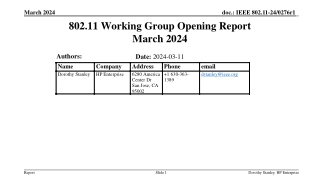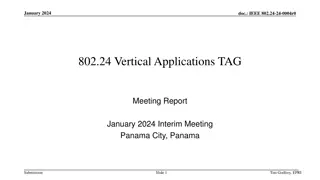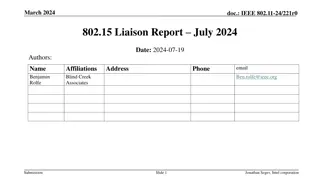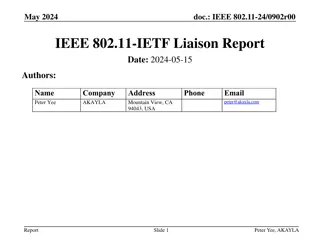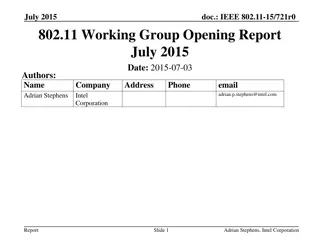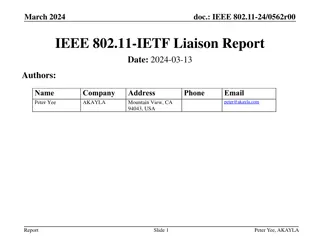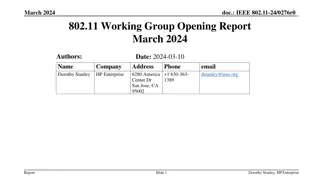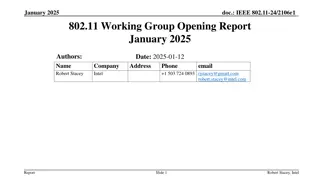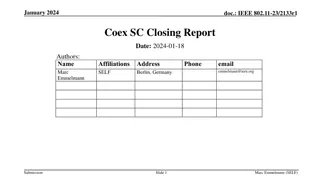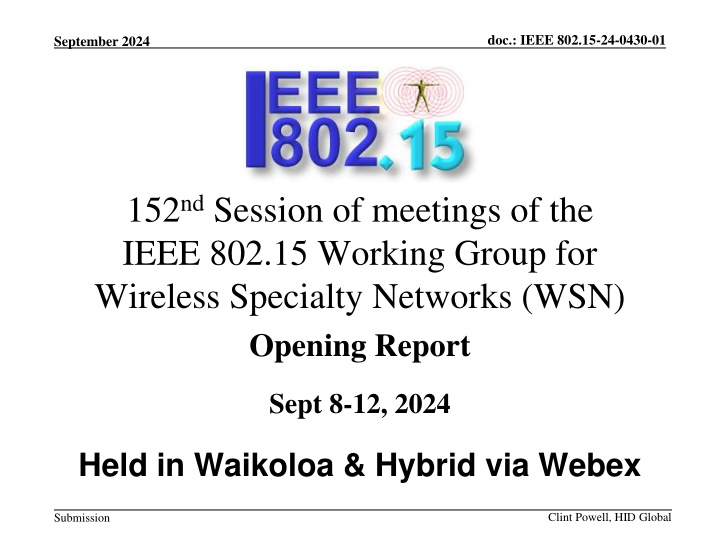
IEEE 802.15 Working Group for Wireless Specialty Networks - September 2024 Meetings Report
Explore the opening report of the 152nd session of the IEEE 802.15 Working Group for Wireless Specialty Networks held in September 2024. Discover insights on group operations, standards development, membership status, and more. Get a glimpse into the group's objectives and ongoing initiatives in the field of wireless networking for IoT.
Download Presentation

Please find below an Image/Link to download the presentation.
The content on the website is provided AS IS for your information and personal use only. It may not be sold, licensed, or shared on other websites without obtaining consent from the author. If you encounter any issues during the download, it is possible that the publisher has removed the file from their server.
You are allowed to download the files provided on this website for personal or commercial use, subject to the condition that they are used lawfully. All files are the property of their respective owners.
The content on the website is provided AS IS for your information and personal use only. It may not be sold, licensed, or shared on other websites without obtaining consent from the author.
E N D
Presentation Transcript
doc.: IEEE 802.15-24-0430-01 September 2024 152ndSession of meetings of the IEEE 802.15 Working Group for Wireless Specialty Networks (WSN) Opening Report Sept 8-12, 2024 Held in Waikoloa & Hybrid via Webex Clint Powell, HID Global Submission
doc.: IEEE 802.15-24-0430-01 September 2024 802.15 WG Org. Chart Clint Powell, HID Global Submission Slide 2
doc.: IEEE 802.15-24-0430-01 September 2024 802.15 WG Standards Pipeline Clint Powell, HID Global Submission Slide 3
doc.: IEEE 802.15-24-0430-01 September 2024 802.15 WG Administrative Voting members: Nearly voting members: Aspirant voting member: Membership roster: 122 3 25 802.15 WG Membership Status 802.15 WG Officers - Elected March 2024 Clint Powell - Chair Phil Beecher - 1st Vice-Chair Ann Krieger - 2nd Vice-Chair Joerg Robert - Secretary (appointed) Tero Kivinen - Tech. Editor (appointed) Ben Rolfe - Treasurer (appointed) Clint Powell, HID Global Submission Slide 4
doc.: IEEE 802.15-24-0430-01 September 2024 802.15 WG Operations 802.15 Operations Manual - covering Membership rules, Voting in the subgroup, Parliamentary procedures for approval to move any deliverables to the Standards Committee for action, officer scope of duties and much more WG15 Op's Manual 802 Operations Links 802 LMSC Op s Manual 802 LMSC P&P 802 LMSC Chairs Guidelines 802 WCSC Op s Manual Clint Powell, HID Global Submission Slide 5
doc.: IEEE 802.15-24-0430-01 September 2024 802 LMSC Annual Review of 802.15 Scope The 802.15 Working Group (WG) on Wireless Specialty Networks (WSN) focuses on the development of open consensus standards addressing wireless networking for the emerging Internet of Things (IoT), allowing these devices to communicate and interoperate with one another, mobile devices, wearables, etc. The goal of 802.15 is to publish standards, recommended practices, or guides that have broad market applicability and deal effectively with the issues of coexistence and interoperability with other wired and wireless networking solutions. Duties Maintain and revise the 802.15 standards, amendments, and recommended practices Develop new standards when a PAR is approved by IEEE SASB and is assigned to the 802.15 WG by the IEEE 802 LMSC Maintain liaisons with other groups within IEEE 802 LMSC, and other relevant standards setting bodies and radio spectrum regulatory bodies Membership See slide 4 Clint Powell, HID Global Submission Slide 6
doc.: IEEE 802.15-24-0430-01 September 2024 Example 802.15 WG Session (see specific mtg. agenda for actual graphic) XYZth IEEE 802.15 WSN SESSION Venue Name & Location The weekly session of the IEEE P802.15 WG on WSN is given in graphic format below. Local Time is meeting location time. SUNDAY MONDAY TUESDAY Date Date Date WEBEX INFO Rx WEDNESDAY THURSDAY FRIDAY Date SATURDAY Date Date Date Local Time Virtual Rm 1 Virtual Rm 2 Virtual Rm 3 Virtual Rm 4 Virtual Rm 1 Virtual Rm 2 Virtual Rm 3 Virtual Rm 4 Virtual Rm 1 Virtual Rm 2 Virtual Rm 3 Virtual Rm 4 Virtual Rm 1 Virtual Rm 2 Virtual Rm 3 Virtual Rm 4 Virtual Rm 1 07:00-07:30 07:30-08:00 08:00-08:30 08:30-09:00 09:00-09:30 09:30-10:00 10:00-10:30 10:30-11:00 11:00-11:30 11:30-12:00 12:00-12:30 12:30-13:00 13:00-13:30 13:30-14:00 14:00-14:30 14:30-15:00 15:00-15:30 15:30-16:00 16:00-16:30 16:30-17:00 17:00-17:30 17:30-18:00 18:00-18:30 18:30-19:00 19:00-19:30 19:30-20:00 20:00-20:30 20:30-21:00 21:00-21:30 21:30-22:00 22:00-22:30 22:30-23:00 CONTINENTAL BREAKFAST CONTINENTAL BREAKFAST CONTINENTAL BREAKFAST CONTINENTAL BREAKFAST 802.15 AC Meeting (Virtual Rm 1) 802 LMSC OPENING MEETING AdHoc Rm Group 4 Group 2 Group 7 Group 2 Group 7 Group 4 Group 2 Group 7 Break Break Break Break 150th Session Shirt Distribution 802.15 WG Midweek Plenary (Virtual Rm 1) Group 5 Group 8 Group 4 Group 9 802.15 WG Opening Plenary (Virtual Rm 1) WNG (Virtual Rm 1) LUNCH LUNCH LUNCH LUNCH 802.15 WG Chair Hr AdHoc Rm AdHoc Rm Group 1 Group 2 Group 3 Group 4 Group 9 Group 8 Group 9 Group 3 Group 4 Group 9 Group 3 802 LMSC CLOSING MEETING Break Break Break Break WIRELESS CHAIRS MTG 802.15 WG Closing Plenary (Virtual Rm 1) 802 JTC1 AdHoc Rm AdHoc Rm Group 4 Group 5 Group 6 Group 4 Group 3 Group 4 Group 6 802.15 AC MEETING (Virtual Rm 1) Break Break Break 802.15 / 802.1 Joint Mtg. Social 802.15 / 802.11 Joint Coex. Mtg. Dinner on your own Dinner on your own Dinner on your own Dinner on your own Dinner on your own Clint Powell, HID Global Submission Slide 7
doc.: IEEE 802.15-24-0430-01 September 2024 2.6a: Designation of Individual Experts for this Session Individual experts who attend electronically for a specific purpose/presentation can be designated as such by the WG Chair and receive a registration fee waiver and limited attendance rights. See section 5 in https://mentor.ieee.org/802-ec/dcn/17/ec-17-0090-25-0PNP-ieee-802-lmsc-operations- manual.pdf , The Working Group Chair may designate specific individual experts who are allowed to participate in Working Group discussions via electronic means during an in-person meeting for the benefit of the group. These individuals are not considered to be attending the meeting and so they are not required to pay meeting fees and they do not get participation credit. The participation of these individuals should be limited to specific technical topics. Such participation shall be documented in the minutes of the Working Group meeting. The individuals listed below are hereby designated as specific individual experts on their respective topics and subject to the restrictions and benefits described in the 802 OM. Jason Yingcheng Liao Ph.D,, Chengdu West Valley Digital Technolgies Inc.., 802.15 WNG n/a n/a n/a n/a For WNG, attendance for each is limited to the WNG timeslot in which the respective presentation is scheduled. Clint Powell, HID Global Submission Slide 8
doc.: IEEE 802.15-24-0430-01 September 2024 IEEE 802.15 Standards & their Applications 802.15.16 802.15.4 Ultra-low Power Sensors Locating and Tracking Automotive FAN/MAN/RAN 802.15.4 Multi-media networks & High Speed Interconnect 802.15.3 Industrial Networks 802.15.6 802.15.7 802.15.13 Medical Critical Infrastructure Networks Consumer Devices Optical Agricultural Sensing Communications Structural Monitoring 9 Clint Powell, HID Global Submission Slide 9
doc.: IEEE 802.15-24-0430-01 September 2024 IEEE 802.15 Subgroups Objectives Clint Powell, HID Global Submission Slide 10
doc.: IEEE 802.15-24-0430-01 September 2024 TG4ab (NG-UWB) - Next Gen. Ultra WideBand Amendment Chair: Ben Rolfe Objective: Enhancements to 802.15.4 Ultra Wideband (UWB) physical layers (PHYs) media access control (MAC), and associated ranging techniques while retaining backward compatibility with enhanced ranging capable devices (ERDEVs). TG4ab Webpage Areas being worked on include: Ranging Link budget improvements Improvements to accuracy, precision and reliability Sensing Pulse shape improvements Channel impulse response reporting to support multistatic sensing To better support presence detection, environment mapping and other uses Data Higher data rates for shorter transmission duration and power savings Channel coding and packet format improvements for robustness Additional options for even greater power savings Protocol enhancements to support very low latency, low energy communications Interference mitigation techniques to support: Greater device density Coexistence in the presence of other users This amendment builds on top of the existing 802.15.4 standard and the 802.15.4z amendment. Clint Powell, HID Global Submission Slide 11
doc.: IEEE 802.15-24-0430-01 September 2024 TG4ac (Privacy) - Privacy Amendment Chair: Tero Kivinen Objective: This amendment specifies modifications to the IEEE Std 802.15.4 MAC specification to specify mechanisms that address and improve user privacy. These mechanisms include randomized addresses, and exchanges that support session continuity. This amendment maintains backward compatibility with the base standard. TG4ac Webpage This amendment builds on top of the existing 802.15.4 standard. Clint Powell, HID Global Submission Slide 12
doc.: IEEE 802.15-24-0430-01 September 2024 TG4ad (NG-SUN PHY) - Next Gen. SUN PHY Chair: Phil Beecher Objective: The amendment specifies modifications for the development of a second-generation physical layer (PHY) for Smart Utility Networks (SUN). The primary focus is the improvement of the OFDM (Orthogonal Frequency Division Multiplexing) modes for higher data rates and longer-range communication, particularly in congested license-exempt frequency bands. TG4ad Webpage Areas being worked on include: Definition of use-cases Number of devices in given area Max. payload bit-rate Latency requirements Definition of frequency bands Channel Models Channel models for indoor and outdoor use Interference models for license-exempt band operation This amendment builds on top of the existing 802.15.4 standard. Clint Powell, HID Global Submission Slide 13
doc.: IEEE 802.15-24-0430-01 September 2024 TG4ae (Ascon Crypt. Alg.) - Amendment Chair: Tero Kivinen Objective: This amendment adds the use of Ascon-128 and Ascon-128a cryptographic algorithms to the IEEE Std 802.15.4. Ascon-128 and Ascon-128a: Ascon is a family of lightweight authenticated ciphers that has been selected by US National Institute of Standards and Technology (NIST) for future standardization of the lightweight cryptography. Ascon provides the same Authenticated Encryption with Associated Data (AEAD) functionality as Advanced Encryption Standard (AES), allowing an Ascon algorithm to be a drop-in. TG4ae Webpage This amendment builds on top of the existing 802.15.4 standard. Clint Powell, HID Global Submission Slide 14
doc.: IEEE 802.15-24-0430-01 September 2024 TG4me (Revision) - Revision to IEEE Std 802.15.4-2020 Chair: Gary Stuebing Objective: This project is needed to incorporate accumulated maintenance changes and corrigenda (editorial and technical corrections) into the standard and to include approved amendments. TG4me Webpage This is a roll up revision incorporating the following amendments: IEEE Std 802.15.4w IEEE Std 802.15.4y IEEE Std 802.15.4z, IEEE Std 802.15.4aa which are approved. One additional amendment, P802.15.4ab, is currently under development. This amendment builds on top of the existing 802.15.4-2020 standard. Clint Powell, HID Global Submission Slide 15
doc.: IEEE 802.15-24-0430-01 September 2024 TG6ma (BAN/VAN) - BAN with Enhanced Dependability Revision Chair: Ryuji Kohno Objective: Enhancements to the Body Area Networks (BAN) Ultra Wideband (UWB) physical layer (PHY) and media access control (MAC) to support enhanced dependability to a human BAN (HBAN), adding support for vehicle BAN (VBAN. TG6ma Webpage Areas being worked on include: Channel Modeling Precise modeling of radio propagation of implant and wearable human BANs and around vehicle BANs for dependable data transmission Classified modeling of multiple BANs and coexistence with other radios for resolution in PHY and MAC Data transmission Cognition of channel environment and coexistence Initial acquisition and synchronization in coexisting BANs FEC and hybrid ARQ according to QoS levels of data packets for various channel models and coexistence classes Packet contention Control and data channels, superframe formant, and MAC function to avoid packet contention in various classes of coexistence Hybrid protocol of contention-free and contention access according to required QoS levels of data packets Inter coordinators or hubs negotiation among coexisting BANs Interference mitigation in coexistence Interference surprising and canceling technologies for theoretical and feasible implementation in coexistence Result in simpler classes of coexistence by mitigation of interference from non-BAN Ranging Optional ranging for cognition of dynamism of coexisting BANs This revision builds on the existing standard 802.15.6-2012 with enhanced dependability for human BAN and additional vehicle BAN Clint Powell, HID Global Submission Slide 16
doc.: IEEE 802.15-24-0430-01 September 2024 TG7a (OCC) - Higher Rate, Longer Range Optical Camera Comms. Chair: Yeong Min Jang Objective: This standard offers a global, secure, high-speed optical communication solution up to 100 Mbps and 200 m, with advantages like access to unlicensed spectrum, inherent security, and AI-enhanced features, promising for commercial and business markets. TG7a Webpage Areas being worked on include: Wavelength range: 10000 nm to 190 nm in optically transparent media. Data rate: Capable of delivering up to 100 Mbit/s. Communication types: Designed for point-to-point and point-to-multipoint communication. Adaptation features: Adaptation to varying channel conditions. Maintaining connectivity during high mobility (up to 350 km/h). Flicker mitigation. Radio Frequency (RF) co-existence. Communication range: Up to 200 m. Technology utilized: Multiple-Input-Multiple-Output (MIMO). MIMO-Orthogonal frequency-division multiplexing (MIMO-OFDM) for dealing with high levels of optical interference while maintaining high- rate data transmission. Additional mechanisms: Relaying mechanisms for enabling heterogeneous operation with existing RF wireless data communications standards. Safety and regulation: Adheres to applicable eye safety regulations. This amendment builds on the existing IEEE 802.15.7-2011 standard and the IEEE 802.15.7-2018 revision. Clint Powell, HID Global Submission Slide 17
doc.: IEEE 802.15-24-0430-01 September 2024 TG9a (EDHOC KMP) - Amendment Chair: Tero Kivinen Objective: This amendment specifies the use of EDHOC (RFC 9528) KMP for the IEEE Std 802.15.9. This standard describes support for transporting KMP datagrams to support the security functionality present in IEEE Std 802.15.4. TG9a Webpage This amendment builds on top of the existing 802.15.4 standard. Clint Powell, HID Global Submission Slide 18
doc.: IEEE 802.15-24-0430-01 September 2024 TG14 (UWB-AHN) - Impulse Radio UWB Wireless Ad Hoc Networks Chair: Clint Powell Objective: Focused on impulse radio (IR) Ultra Wideband (UWB) PHY and MAC providing precision ranging capability that is accurate to the centimeter level by including (via. referencing) the 802.15.4 IR UWB functionality into a simple focused specification. TG14 Webpage Objective This TG is currently in hibernation awaiting the outcome/conclusion of the TG4me revision, to see if has satisfied the objective of this project. This project is for a new standards that references 802.15.4. Clint Powell, HID Global Submission Slide 19
doc.: IEEE 802.15-24-0430-01 September 2024 TG15 (NB-AHN) - Narrow Band Wireless Ad Hoc Networks Chair: Phil Beecher Objective: Focused on narrow band ad hoc network PHY and MAC by including (via referencing) functionality and features of 802.15.4 into a simple focused specification. TG15 Webpage Objective This TG is currently in hibernation awaiting the outcome/conclusion of the TG4me revision, to see if has satisfied the objective of this project. This project is for a new standards that references 802.15.4. Clint Powell, HID Global Submission Slide 20
doc.: IEEE 802.15-24-0430-01 September 2024 TG16t (Lic-NB) - Licensed Narrowband Amendment Chair: Tim Godfrey Objective: Enhancements to IEEE 802.16-2017 physical layer (PHYs) and media access control (MAC) to enable operation in licensed spectrum with channel bandwidths greater than or equal to 5 kHz and less than 100 kHz. The amendment is frequency independent but focuses on spectrum less than 2 GHz. The range and data rate supported by the narrower channels are commensurate with those of the base standard, as scaled by the reduced channel bandwidth. The project also amends IEEE Std 802.16 as required to support aggregated operation in adjacent and non- adjacent channels. TG16t Webpage Areas being worked on include: Definition of the Wireless MAN-NB PHY to enable operation in narrow channels Aggregation of non-contiguous narrow channels to provide higher capacity Enhancements to MAC to improve efficiency and reduce control overhead Definition of a Direct Peer-to-Peer (DPP) mode to support operation without fixed infrastructure Updates to security protocols This amendment is to the IEEE 802.16-2017 base standard. Clint Powell, HID Global Submission Slide 21
doc.: IEEE 802.15-24-0430-01 September 2024 IG Access - WG15 Access Techniques Chair: Ben Rolfe Objective: Determine interest in starting efforts for development of projects on 802.15 Access Techniques. Clint Powell, HID Global Submission Slide 22
doc.: IEEE 802.15-24-0430-01 September 2024 IG (NG-OWC) - Next Gen. Optical Wireless Communication Chair: Yeong Min Jang Objective: Development of next-generation optical wireless communication (NG-OWC) characteristics and its future applications. Areas being worked on include: Artificial Intelligence (AI) for NG-OWC Integration of various AI technologies into the OWC system Lightweight AI utilization for each developed AI technology Channel modelling for NG-OWC Integration of machine-learning for channel estimation Utilization of machine learning for channel estimation for dynamic and complex channel conditions Future applications of NG-OWC NG-OWC encompasses fields such as IoT, underwater communication, joint communication, sensing, and localization (V2V, M2M, Drone/UAV, etc.) NG-OWC for OWC based drone Networks NG-OWC for Indoor/Outdoor Positioning through OWC and LiDAR integration Deep learning-based OWC to support high mobility vehicle Preferred camera types for OWC Resolution: Minimum 720x540 (single-link), maximum 3840 x 2160 (multi-link) Frame rate: Minimum 30 FPS, preferred more than 120 FPS Spectrum: Mono, color Light sources: IR, VL, and UV This group will evaluate the interest in developing Next Gen OWC capabilities Clint Powell, HID Global Submission Slide 23
doc.: IEEE 802.15-24-0430-01 September 2024 SC IETF - Internet Engineering Task Force Chair: Tero Kivinen Objective: This standing committee brings in the information from the Internet Engineering Task Force (IETF) to the 802.15 working group. It concentrates on the IETF working groups that might be of interest to the 802.15 working group members. SC IETF Webpage IETF working groups followed include: 6lo, lake, suit Clint Powell, HID Global Submission Slide 24
doc.: IEEE 802.15-24-0430-01 September 2024 SC MAINT - 802.15 Maintenance Activities Chair: Phil Beecher Objective: The Standing Committee Maintenance (SCM) has the following roles: Reviewing comments related to possible errata on 802.15 standards and making recommendations to 802.15 Working Group Managing and maintaining the 802.15 Operations Manual Managing and maintaining the 802.15 Motion templates and project checklist template Reviewing 802 PARs and ICAIDs on behalf of 802.15 Working Group SC MAINT Webpage SCM meets at least once during every 802 plenary and 802 wireless interim session Clint Powell, HID Global Submission Slide 25
doc.: IEEE 802.15-24-0430-01 September 2024 SC THz - THz Standing Committee Chair: Thomas K rner Objective: The IEEE 802.15 Standing Committee Terahertz is chartered to explore the feasibility of Terahertz for wireless communications. The Terahertz frequency band runs roughly from 300 GHz to 3 THz, a staggering 2700 GHz of bandwidth. SC THz Webpage Areas being worked on include: The IEEE 802.15 Standing Committee Terahertz is soliciting, and hearing, contributions that address numerous THz issues. There are no immediate plans to transition the group to a study group or a task group; rather, we want to fully understand the technology status in regards to a further amendment of IEEE Std. 805.15.3-2023 or a completely new standard. Apart from the implementation aspects of THz Communications there are important regulatory aspects to be considered. For example the allocation and identification of THz spectrum especially in conjunction with the agenda items at WRC-27 and WRC-31 are topics of the THz standing committee. Clint Powell, HID Global Submission Slide 26
doc.: IEEE 802.15-24-0430-01 September 2024 SC WNG - Wireless Next Generation Chair: Ben Rolfe Objective: The IEEE 802.15 Standing Committee Wireless Next Generation is chartered to facilitate discussions on new Wireless related Technologies that may be of interest to the 802.15 community, and that may lead to new 802.15 standardization projects. The WNG also provides the opportunity to address the whole 802.15 work group with issues or concerns with current techniques or technologies. SC WNG Webpage Areas being worked on include: WNG topics are not limited to only the PHY layer and/or the MAC sublayer since information on the layers above the MAC including the application is very important to making sure that the PHY and MAC are appropriate, especially in the WSN environment. Presenters in WNG are usually asked to relate the material presented and/or discussed to the work of the WG via the usual question : What do you propose the Working Group do next? The answer usually falls into one of these categories: a) Information for the group b) Form an interest group to pursue c) Consider in the future a new project Clint Powell, HID Global Submission Slide 27
doc.: IEEE 802.15-24-0430-01 September 2024 Subgroups Objectives this Session TG 4ab (NG-UWB) 1. Conduct comment resolution for the Initial Letter Ballot 2. Determine whether or not to start a Letter Ballot Recirc. TG 4ac (Privacy) 1. Continue hearing presentations on technical areas and preparing draft 2. Update preliminary timeline for TG TG 4ad (NG-SUN PHYs) 1. Continue hearing presentations on technical areas and channel modeling 2. Update preliminary timeline for TG TG 4ae (Ascon Crypt. Alg.) 1. Begin hearing presentations on technical areas to include in the draft 2. Develop preliminary timeline for TG Clint Powell, HID Global Submission Slide 28
doc.: IEEE 802.15-24-0430-01 September 2024 Subgroups Objectives this Session TG 4me (Revision) 1. Review any feedback from RevCom TG 6ma (Revision + BAN/VAN) 1. Conduct comment resolution for the Initial Letter Ballot 2. Determine whether or not to start a Letter Ballot Recirc. TG 7a (OCC) 1. Review any feedback from RevCom TG 9a (EDHOC KMP) 1. Begin hearing presentations on technical areas to include in the draft 2. Develop preliminary timeline for TG Clint Powell, HID Global Submission Slide 29
doc.: IEEE 802.15-24-0430-01 September 2024 Subgroups Objectives this Session TG 14 (UWB-AHN) in hibernation, no meetings TG 15 (NB-AHN) in hibernation, no meetings TG 16t (Lic-NB) 1. Conduct comment resolution for the Initial SA Ballot 2. Determine whether or not to start a SA Ballot Recirc. Clint Powell, HID Global Submission Slide 30
doc.: IEEE 802.15-24-0430-01 September 2024 Subgroups Objectives this Session Joint 802.11/802.15 1. Meeting w/802.11 on Tues. eve. IG Access 1. Continue discussing interest in potential projects IG NG-OWC 1. Hear additional presentations 2. Continue to assess readiness to start Study Group Clint Powell, HID Global Submission Slide 31
doc.: IEEE 802.15-24-0430-01 September 2024 Subgroups Objectives this Session SC MAINTENANCE 1. Review draft of detailed development process steps checklist 2. Review list of all templates for WG15 Subpage for completeness 3. Review WG15 P&P for any updates SC IETF 1. Discuss IETF activities related to 802/802.15 at WG15 mid-week SC THz 1. Not meeting this session SC WNG 1. Hearing presentations on WSN related topics Clint Powell, HID Global Submission Slide 32

